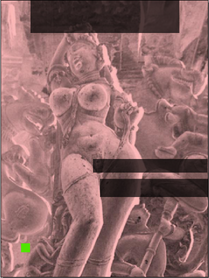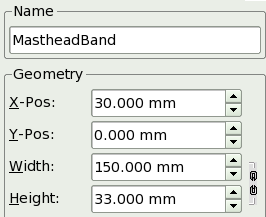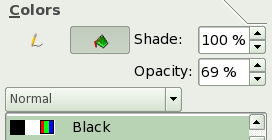Get Started With Scribus:4
Get Started With Scribus 2006
| ||||||||
Chapter 4
|
- What Can You Do With Scribus
- Scribus And Its Sisters
- Empty, White Spaces
- Cover Page
- Working With Layers On A Page
- Design Multiple Pages
- Create Final Page Layouts
- Design With Graphics And
Freedom - Set Fire With SVG Graphics
- Publishing Demands Freedom.PDF.
- Travel At The Speed Of Scribus
- Contributors
- GNU Free Documentation Licence
Cover Page
If you see too many gridlines on your blank page, unselect View > Show Grid. You will see blue-colored lines marking the outer margins of your page. The concept of Scribus is quite simple: To place a photo on the page, first you must create an image frame and then import the photo into this frame. Similarly, to place text on the page, you must create a text frame first, and then insert, or type, text into this frame. You'll soon discover that this approach has some great advantages.
Insert Picture
A toolbar contains all the Tools that Scribus offers. You can use this link to get your bearings, but remember that gliding your mouse over each icon will display a tool tip with the name of each tool. Click on the one that looks like this (Insert Image Frame ![]() )[keyboard: I]. This allows you to insert an image frame in the page. That's what you want for placing the cover picture. Drag your mouse from the top-left of the Scribus page, to the bottom-right, or any corner to its opposite. Don't worry if you don't get it exactly right.
)[keyboard: I]. This allows you to insert an image frame in the page. That's what you want for placing the cover picture. Drag your mouse from the top-left of the Scribus page, to the bottom-right, or any corner to its opposite. Don't worry if you don't get it exactly right.
You'll find an image frame drawn on your page, in the shape of a large rectangle, with black-colored diagonal lines forming a large 'X' through it . This is a traditional printing industry custom, to distinguish image frames from text frames. That 'X' won't ever print, so don't worry.
Soul of Scribus
When Scribus opens for the first time, you should see - along with the main window - a persistently open dialog box with the title of "Properties". This dialog box - called the Properties Palette - is where you will make most of your formatting choices and is where you control what happens to all of the objects you add to your document.
If the Properties Palette is not shown, you can go to menu Windows → Properties or press PF2 to open it. You should normally keep the Properties Palette open at all times since you will be using it a lot.
The Properties Palette contains various tabs/sections - X,Y,Z; Shape; Text; Image; etc. - which allow you to control different aspects of the selected object(s). The options available in the Properties Palette automatically change depending on which object(s) are selected. For example, if the object you have selected does not allow text input - such as an image frame - then the Text tab will not be available.
In this documentation, if you are told to open the Properties Palette it is simply a reminder that the Properties Palette should be open at all times.
Make sure the image frame you just created is highlighted, or selected. Usually red-colored or other colored square dots will mark all the four corners as a visual cue. If not, in the Toolbar, click on the first icon ![]() (Select Item), and just click on the image frame. The Properties Palette will instantly show all its details. An object must be selected to be modified or deleted.
(Select Item), and just click on the image frame. The Properties Palette will instantly show all its details. An object must be selected to be modified or deleted.
Give a human-readable label to this image frame, such as 'CoverPhotoFrame' in the 'Name' field of Properties. In case you do not see the 'Name' field, just click once on the top tab, that says X,Y,Z. Next, precisely place the top-left of your picture frame on the top-left edge of your page. In the X-Pos and Y-Pos fields, type in the values of 0mm, each. Pos is obviously a short-form of Position. Type in the Width and Height at 210 mm and 280 mm respectively. Your frame is precisely placed on the page (note that these figures will result in incorrect placing for users of the A4 standard page). While you can resize and reposition with the mouse, typing in values is much faster for a task like this.
Get Picture
After you make sure your image frame is selected, then right-click anywhere inside this image frame. You will see a Context Menu pop-up right under the mouse cursor. Select Get Image from this menu (before 1.3.x this is Get Picture...). A file dialog box opens up for you to navigate into your FYug folder, and then into the images folder, so you can select the 'TitleFX.jpg' sample image. Click on the OK button. The image frame on your Scribus page is immediately filled with the TitleFX.jpg image.
Nudge Picture to Left
Note the sculpture in the image is too much to the right. We must drag the picture inside the image frame to the left, so that the sculpture is positioned in the centre of the image frame. Extra parts of the picture will get automatically cropped out of view beyond the boundaries of the image frame. First, let's play with this positioning with the mouse. On the toolbar, click on the icon for Edit Contents of Frame ![]() .
.
Now when you left click inside the image frame you can manually slide your picture around, and for some projects this may be accurate enough. For our project let's be very precise. First, make sure the image frame is selected (click Select Item on the toolbar then click your frame again, or try this: left-click outside your frame and you will see the Select Item icon become highlighted, then left-click inside the frame to select it). Now go back to the Properties Tool (F2) and click on the tab titled 'Image'. In the field marked X-Pos, just type in the value “-90mm” to move the image 90 mm to the left. Note how the image is shifted inside the image frame (depending on your system, the display may take a few moments to refresh itself to account for this edit)
Color Karma
At the bottom of the Properties Tool (Image tab), you may have noticed a section called 'Input Profiles.' This will only show if the LittleCMS on your PC is correctly installed and configured. The color of your images may look markedly different on your screen, and even more when you print them. This little area minimizes such color mismatch. From the pop-up for 'Input Profile', choose a color profile that closely matches your monitor. Scribus immediately re-renders the image on the screen to display colors according to that profile.
The actual installation of LittleCMS and how to use it under Scribus is actually quite simple, but beyond the scope of this tutorial. For more details, see the Scribus wiki page. Here are some good tips:
- Download a set of free profiles from the Adobe site, so you can send images between Mac, Windows, and Linux.
- Create a custom color profile of your own monitor and use that instead of any other.
Save
You may want to save your file before proceeding. So head over to File>Save and type the name 'Fyug.sla' for your file. Save it in the FYug folder. You can also just click on the floppy icon in the taskbar, right underneath the menus, to save your file.![]()
Masthead Band
The cover page of any magazine has its name emblazoned across the top. This is called the Masthead. Ours is titled “FreedomYug.” We'll start by creating a semi-transparent band for the Masthead. Go to File > Preferences > PDF Export (before 1.3.x Settings > Preferences > Display). On macosx sytems, it is scribus > preferences. Make sure this checked: “Use PDF1.4 Transparency Features” (In 1.3.x make sure the PDF 1.4 is chosen under Compatibility). Click OK. In scribus 1.4 you have a choice of PDF compatibility options. At this point, you will want to choose the correct option. Your document now supports transparent objects.
Click the tool marked ![]() in the Toolbar. Should you hover your mouse over this, the roll-over text would display “Draw Various Shapes” or something similar. Select the rectangle shape from the drop-down menu. Click anywhere near the top-centre of the page and draw a rectangle. Make sure the rectangle is selected, and immediately go to the Properties Tool, click on the X,Y,Z tab, and enter the following values: X-Pos: 30mm. Y-Pos: 0mm. Width: 150mm. Height: 33mm (observe that these values are incorrect for a standard A4 page). Give it a name, such as 'MastheadBand' in the Name field.
in the Toolbar. Should you hover your mouse over this, the roll-over text would display “Draw Various Shapes” or something similar. Select the rectangle shape from the drop-down menu. Click anywhere near the top-centre of the page and draw a rectangle. Make sure the rectangle is selected, and immediately go to the Properties Tool, click on the X,Y,Z tab, and enter the following values: X-Pos: 30mm. Y-Pos: 0mm. Width: 150mm. Height: 33mm (observe that these values are incorrect for a standard A4 page). Give it a name, such as 'MastheadBand' in the Name field.
Then click on the Colors tab in Properties. Click the Pencil tool ![]() to select the stroke or outline border. Click on 'None' in the colors list. Then, click the bucket icon to select the fill color. Click on 'Black' from the list of colors, and in the opacity field, enter 69% (if you do not see an Opacity field, you have not selected PDF 1.4 transparency features -- see first paragraph above in this section). You will see the band has turned semi-transparent, and partly shows the image through itself, in darkened colors. Experiment with Opacity and other colors to your taste.
to select the stroke or outline border. Click on 'None' in the colors list. Then, click the bucket icon to select the fill color. Click on 'Black' from the list of colors, and in the opacity field, enter 69% (if you do not see an Opacity field, you have not selected PDF 1.4 transparency features -- see first paragraph above in this section). You will see the band has turned semi-transparent, and partly shows the image through itself, in darkened colors. Experiment with Opacity and other colors to your taste.
Add More Bands
Draw another rectangle towards the centre of the image. In the Properties Tool (X,Y,Z), give X-Pos: 93mm. Y-Pos: 160mm. Width: 115.35mm. Height: 13.75mm. Again in Colors, set the stroke to 'None', and the fill with 'Black' at an opacity of 69%. Call this the 'HeadlineBand'. A third rectangle, named 'SubHeadBand' can be drawn slightly underneath this, at X-Pos: 100mm. y-Pos: 180mm. Width: 109.7mm. Height: 18.35mm. The fourth and final rectangle, this time a little square box, will have the following Properties: X-Pos: 20.5mm. Y-Pos: 245mm. Width and Height will both be 9mm.
| Here is a shortcut you might try for a repetitive job like this. Instead of making each rectangle from scratch, then changing all of these parameters, after you make the first one and adjust its colors, just copy it: Item > Duplicate. Then all you have to adjust is its name, position, and size. |
Create Colors
| Hold on! Don't fill this with the same 69% Black. Let's give it a fresh lime green color. Go to Edit > Colors... in the menu. A dialog box listing existing colors displays on your screen. Click on 'New' and give your new color swatch a name, 'Lime Green' (if you already have a LimeGreen, call it LimeGreen2 or something else). In the second dialog-box that opens up, choose 'CMYK' as the Color Model. This closely follows the inks of Cyan, Magenta, Yellow, and Black, used in your desktop printer and in printing plants, that mix inks to create new colors. With the sliders at the bottom, give C:69%, M: 10%, Y:100%, and K: 0%.
Click OK in this dialog box, and then click OK again in the Colors dialog box, where you'll notice your new color added. Go back to your page, click on the small square you just created, and in the Colors tab of Properties Tool, give it a stroke of None, and a fill of LimeGreen, at 100% opacity. You cover should look like the screenshot here, with all the bands for text. |

|
Locked Bands
One last thing. Select each semi-transparant band individually, and in the Properties palette, in the X,Y,Z tab, click on the icon of the padlock ![]() at the bottom. This ensures you accidentally do not move or resize each locked object.
at the bottom. This ensures you accidentally do not move or resize each locked object.
Similarly, lock the CoverPicture Frame as well, and the green square, using this padlock. Also, uncheck 'Text Flows Around Frame' in the Shape tab of the Properties Tool for each of these rectangles. This allows text to overlap the rectangles.




